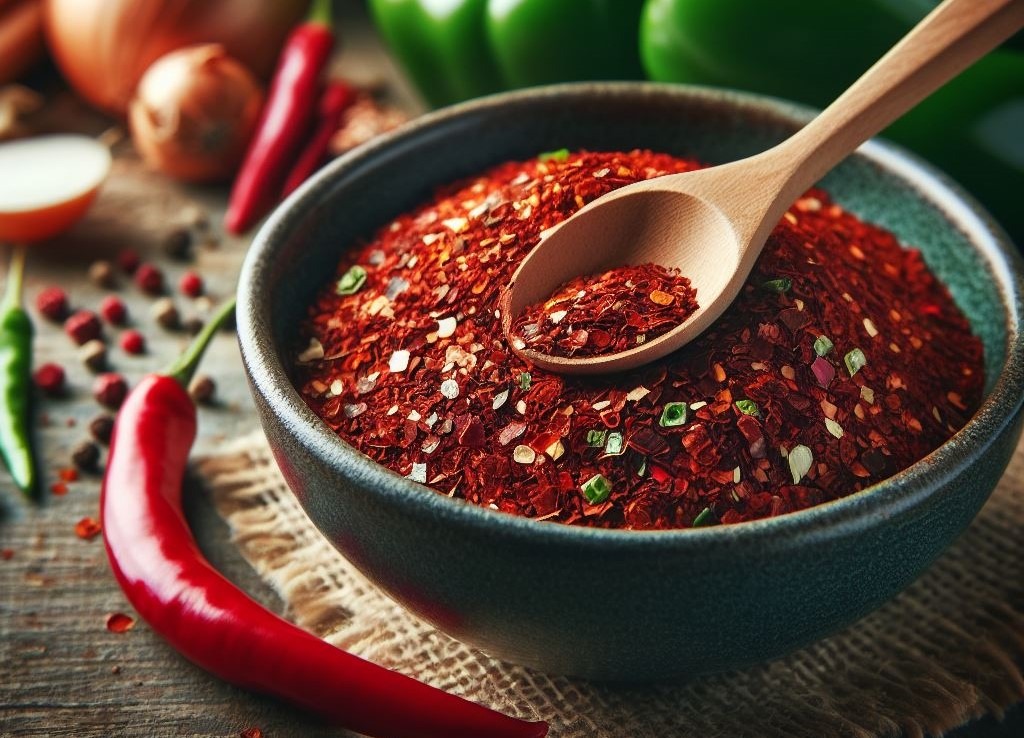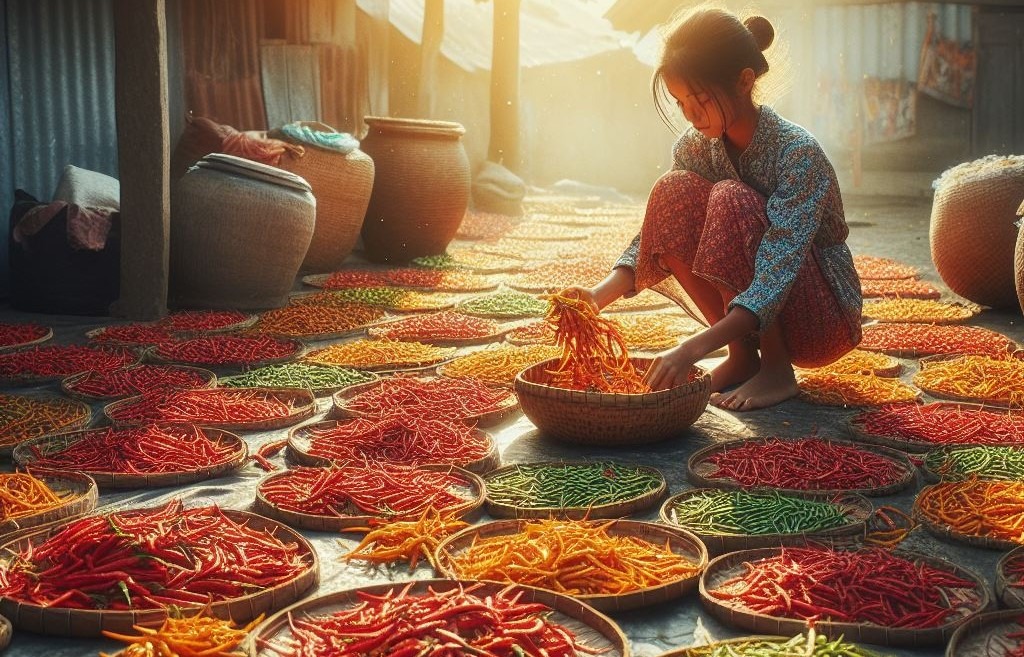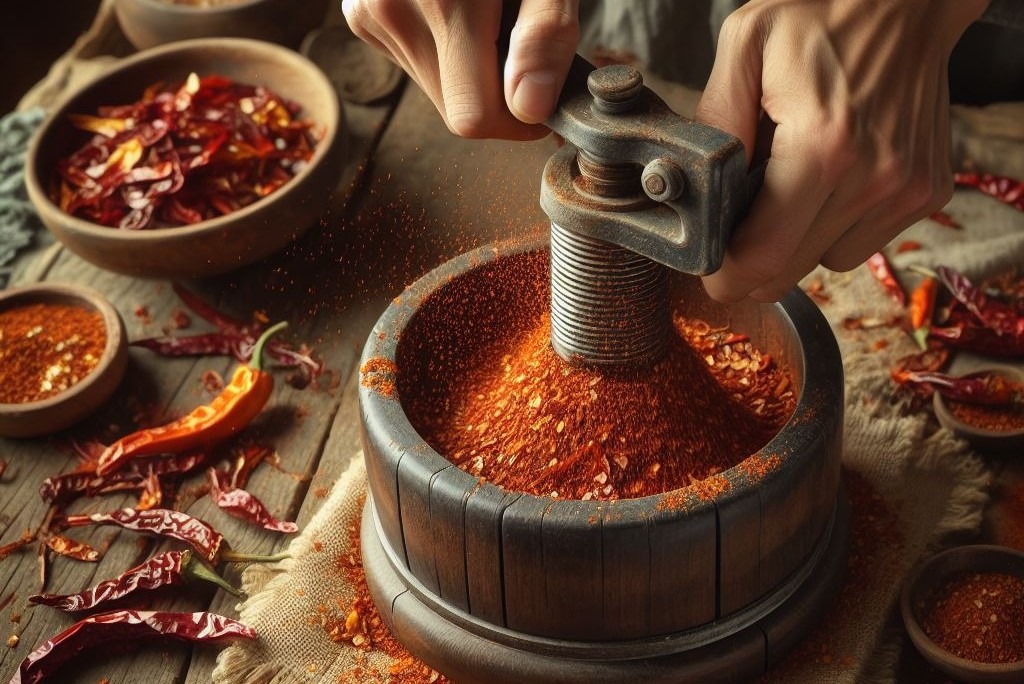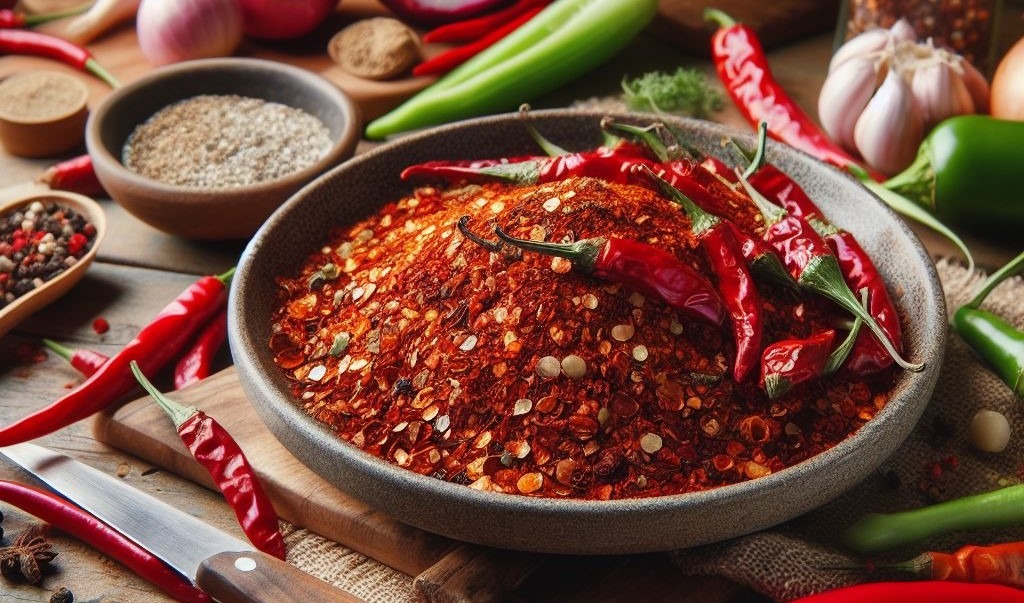Chili flakes, often regarded as mere heat boosters, have a universe of secrets waiting to be discovered. Contrary to the common belief that they’re just for adding spice, chili flakes bring much more to the table. Let’s delve into the intriguing world of what are chili flakes and uncover surprising facts that will transform your culinary journey.
What Are Chili Flakes?
Chili flakes, those tiny specks of fiery delight, are much more than just a way to amp up the heat in your dishes. Originating from dried chili peppers, these flakes pack a punch, adding not only spiciness but also a depth of flavor to your meals. Chili aren’t limited to one type – they come in various varieties, each with its unique characteristics.

Uses OF Chili Flakes
Here are some uses of chili flakes.
Health Benefits of Chili Pepper Flakes
It is a common belief that chili is harsh on your system, but capsaicin can rev up your metabolism, aiding in weight loss. Embrace the burn, and let your metabolism dance to the tune of chili-infused vitality.
Incorporating Chili Flakes for Weight Loss
Beyond the flavor enhancement, chili can curb appetite and increase calorie burn – a subtle yet effective nudge toward your fitness goals. Spice up your meals and let the heat pave the way to a healthier you.
Also read: Dehydrate Oregano Recipe
Quick and Easy Recipes for Beginners: Spice Up Your Kitchen
Incorporating them into your kitchen repertoire doesn’t require a culinary degree. Start with simple recipes like chili infused olive oil or sprinkle a pinch over your favorite pasta dish. Gradually, you’ll find your comfort zone in balancing the heat and flavor.
Vegan Recipes with Chili
Chili flakes are more than just a spice – they’re a secret weapon for elevating vegan dishes. Whether it’s a tofu stir-fry or a roasted vegetable medley, it adds a layer of complexity to your plant-powered creations. Embrace the spicy side of vegan cooking and discover a new dimension of flavor.
How to Make Chili Flakes
We’ll explore the step-by-step process of crafting your flakes, ensuring a fresh and personalized spice experience that’s as easy as it is rewarding.
1. Selecting the Right Chili Peppers

The choice of chili peppers significantly impacts the flavor and heat of your chili flakes. Opt for varieties that align with your desired spice level, whether it’s the milder Anaheim or the fiery Thai bird’s eye chili.
2. Drying the Chili Peppers

Drying chili peppers for homemade chili flakes is a crucial step. Lay the selected peppers on a clean surface, ensuring good airflow, and let them air dry. Alternatively, use a food dehydrator or your oven on a low setting. The goal is to eliminate moisture, so be patient during this process.
3. De-seeding for Controlled Heat
If you prefer a milder heat, consider de-seeding the chili peppers before grinding. The seeds and membranes hold a significant amount of heat, so removing them allows you to control the spice level according to your taste.
4. Grinding the Dried Peppers

Once the chili peppers are fully dried, it’s time to turn them into flakes. Use a spice grinder, mortar and pestle, or even a food processor to achieve the desired consistency. Grind them coarsely for a textured finish or finely for a smoother result.
5. Storing Your Homemade Chili Flakes
Proper storage ensures the longevity of your homemade flakes. Opt for airtight containers kept in a cool, dark place to shield them from moisture and sunlight. This way, you’ll have a supply of fresh, homemade chili flakes ready to enhance your dishes.
6. Experimenting and Adjusting
The beauty of making chili flakes at home is the freedom to experiment. Start with small batches, adjusting the chili variety and quantity to find your perfect spice blend. This personalized touch ensures your chili is tailor-made for your taste buds.
Also read: Make Bone Broth In Crock Pot
Types of Chili Flakes
Here are some common types.
1. Cayenne Pepper Flakes:
Ideal for those who love a fiery kick, these flakes elevate dishes, adding a robust heat that lingers on the palate. Use them sparingly if you prefer a milder touch or go all in for an adventurous spice experience.
2. Chipotle Flakes:
Chipotle flakes bring a smoky sophistication to the table, enhancing dishes with their distinct, rich flavor. Derived from smoked jalapeños, these flakes offer a unique balance of heat and smokiness, making them a favorite for barbecue rubs, marinades, and dishes where a hint of smokiness is desired.
3. Aleppo Pepper Flakes:
For those who prefer a milder heat with a hint of fruitiness, Aleppo pepper flakes are a delightful choice. Originating from the Middle East, these flakes impart a gentle warmth, making them perfect for enhancing the flavor of salads, dips, or Mediterranean-inspired dishes.
4. Thai Bird’s Eye Chili Flakes:
Thai bird’s eye chili flakes bring an intense zing to your dishes, capturing the essence of Thai cuisine. Known for their potent heat, these flakes are perfect for adding spice to stir-fries, curries, and noodle dishes, providing an authentic Thai culinary experience.
5. Red Jalapeño Flakes:
Red jalapeño flakes offer a vibrant, versatile heat that suits a range of dishes. Whether sprinkled on pizzas, incorporated into salsas, or used to spice up soups, these flakes bring a well-rounded, medium heat that complements a variety of cuisines.
6. Habanero Flakes:
For daring spice enthusiasts, habanero flakes provide a fiery eruption of heat. Handle with caution, as these flakes deliver intense spiciness. A small amount goes a long way, making them ideal for individuals seeking an exhilarating, palate-tingling experience.
Also read: Protein In 6 Oz Steak
Spice Up Your Culinary Adventures
From global cuisines to unexpected desserts, the world of chili is vast and waiting for you to explore.
1. Chili Flakes in Different Cultural Cuisines
Chili flakes aren’t bound by borders – they’re welcomed in kitchens worldwide. From the fiery curries of Indian cuisine to the zesty stir-fries of Asian dishes, chili play a starring role. Experiment with different cultural recipes and let chili take your taste buds on a journey around the globe.
2. Enhancing Flavor in Everyday Meals
Spice isn’t just for special occasions. Elevate your everyday dishes by incorporating chili flakes into your routine. Whether it’s a simple omelet for breakfast or a hearty soup for dinner, a sprinkle of chili can turn the ordinary into the extraordinary.
3. Exploring Chili Flakes in Desserts
If you think chili flakes are reserved for savory dishes, think again. Explore the unique combination of sweet and spicy by adding a pinch of chili to your desserts. From chocolate truffles to fruit salads, chili can add a surprising twist that tantalizes your taste buds.
Also read: Which Is Healthy: Rapeseed Oil Vs Olive Oil
Chili Flakes in Global Cuisines
Explore the versatility of chili in global cuisines. Get ready to embark on a culinary journey that spans continents.
1. Integrating Chili Flakes in Asian and Mediterranean Cuisines
Asian Aromas and Mediterranean Marvels
Chili flakes are more than just a pizza topping – they’re a welcome addition to Asian and Mediterranean dishes. From the heat of a Thai stir-fry to the robust flavors of Mediterranean pasta, chili can seamlessly integrate, adding a layer of complexity that elevates these cuisines.
2. Spice Secrets in Thai Cuisine
Transforming Thai Dishes
Thai cuisine, known for its harmonious balance of flavors, welcomes the addition of chili flakes with open arms. Sprinkle them into your Pad Thai, stir-fries, or noodle dishes to infuse a delightful heat that complements the sweet, sour, and savory notes inherent in Thai cooking.
3. Mexican Dishes
Spice Up Your Tacos and Salsas
Mexican cuisine welcomes the heat of chili flakes with open arms. Sprinkle them into your guacamole, add a pinch to your tacos, or infuse them into your salsa for an extra layer of depth and excitement.
Also read: Protein In Lentil Soup
How Hot Are These Crushed Chili Pepper Products?
We’ll explore the heat levels of crushed chili pepper products, understanding that the spice spectrum is vast. Get ready to navigate the fiery nuances and discover the perfect level of heat for your taste buds.
1. The Scoville Scale: Decoding Spice Levels
Mild options like Anaheim peppers hover at the lower end, while cayenne peppers and beyond venture into the higher ranges. Knowing where your crushed chili pepper product falls on this scale can help you gauge its potential impact on your dishes.
2. Variability Across Brands and Types
It’s essential to recognize that the heat levels can vary between different brands and types of crushed chili pepper products. Factors like the type of chili used, processing methods, and even the region of cultivation can influence the final heat intensity. Always check the label for any specific information regarding Scoville Heat Units (SHU) or heat levels.
3. Balancing Heat in Your Dishes
Understanding the heat level of your crushed chili pepper product allows you to balance it in your dishes. For those who prefer milder flavors, use sparingly or opt for a milder chili variety. If you’re a heat enthusiast, explore higher-scoring peppers and experiment with different quantities to find your ideal spice level.
4. Incorporating Heat Responsibly
Spicing up your dishes doesn’t mean overwhelming them with heat. Whether you’re cooking for yourself or a group, start with a small amount of crushed chili pepper and adjust gradually. This way, you can savor the spice without compromising the overall flavor profile.
Chili Flakes vs. Red Pepper:
They may seem similar, but each brings its distinct qualities to the table. Get ready to unravel the spice mystery and make informed choices for your culinary adventures.
1. Defining Chili Flakes and Red Pepper
The terms “chili flakes” and “red pepper” are often used interchangeably, but they aren’t identical. Chili flakes typically consist of dried and crushed red chili peppers, offering both heat and flavor. On the other hand, red pepper can include a blend of dried red chili peppers, seeds, and sometimes additional spices.
2. Flavor Profile: Heat and Beyond
While both chili flakes and red peppers bring heat, their flavor profiles can differ. It often provides a more complex flavor, with variations like smokiness in chipotle flakes or sweetness in some varieties. Red pepper, being a blend, might have a slightly less nuanced taste, focusing primarily on spiciness.
3. Culinary Applications: When to Choose What
Understanding when to reach for chili flakes or red peppers can enhance your dishes. With their distinct flavor, are excellent for dishes where you want to highlight the spice without overwhelming the overall taste. Red pepper, with its heat-forward profile, can be a go-to for quick, bold seasoning.
4. Where to Buy the Best Quality
When it comes to purchasing these spices, quality matters. Seek out reputable sources, either online or at local spice shops, ensuring you get the best quality for your culinary creations.
In conclusion of what are chili flakes, despite being underappreciated as a straightforward spice, it have a rich and varied flavor profile. With a range of flavors to complement culinary masterpieces, from the robust heat of cayenne to the elegant smokey notes of chipotle and the mild, fruity notes of Aleppo, each kind adds something special to the dish.
Also read
How Hot Chocolate Help You Sleep
How To Smoke A Fish In A Smoker: Complete Guide And Tips
FAQs
Here are some common questions.
Although red pepper and chili flakes are frequently used interchangeably, there are some minor distinctions between them. Typically, dried and crushed red chili peppers are used to make chili flakes, which have a flavorful and spicy blend. Red pepper flakes, on the other hand, could contain extra spices and seeds, giving them a somewhat different flavor character. Even though the terms are frequently used synonymously, it’s important to read product labels carefully to ensure that the ingredients and heat levels are correct.
If you are out of that, you can make a substitute using spicy sauce, paprika, cayenne pepper, or red pepper flakes. Chili flakes are similar in texture and heat to crushed red pepper in particular. Adapt the amounts to your preferred level of spiciness. To get a similar heat, try experimenting with various spices like black pepper or even finely chopped fresh chili peppers. Make adjustments according to the flavor profile you want for your food.
Crushed red pepper flakes are another name for chili flakes. Dried chili peppers are crushed into tiny, delicious pieces to make them. These flakes give a dish’s flavor and richness. Crushed chile or red pepper flakes are some more terms. These names are frequently used interchangeably according to local inclinations.





